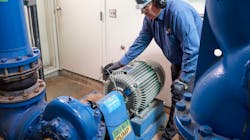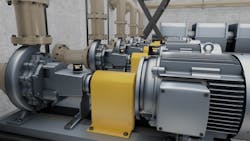An effective maintenance program can increase uptime, decrease maintenance costs, reduce unplanned downtime and extend asset life. All of these drive business value, which is especially important in today’s competitive and challenging environment. Teams everywhere are being asked to do more with less. But how do you ensure that your maintenance program can help meet these goals?
It comes down to data — but data on its own is not enough. Getting the right data, and using it effectively, makes it possible to maximize asset availability and performance, and to minimize potential failures — and their impact. Analysis is just as important as the data itself. Understanding what the data says, and how to act on it, is how maintenance teams can find and fix problems before breakdowns occur, resulting in safer, more efficient and more productive operations. On a basic level, it is about listening to your machines.
Monitoring the condition of your machines provides you with insights into their health and performance. Vibration data, temperature data and power monitoring are a few traits that can be monitored and assessed. Over time, condition monitoring also makes it easy to spot trends and plan responses. Managing resources, including labor, is easier when you are not merely reacting. Factors such as a machine’s history and criticality can help you plan and prioritize your maintenance actions.
Maintaining machines based on their actual condition, rather than basing maintenance actions on a calendar, reduces work that is performed whether it is necessary or not. This saves time, money and parts, and reduces instances when errors could occur. Condition monitoring assesses the real-time health of machines and the likelihood of failures, then uses that data to drive maintenance decisions.
A full picture of asset health with condition monitoring
A machine’s condition data can be monitored and transmitted by sensors mounted on the machine. When these internet-enabled devices, such as vibration sensors or power monitors, are connected to software, around-the-clock measurement data can be aggregated and organized. This helps teams identify and troubleshoot potential problems. With data automatically sent to the cloud, teams can access it from wherever they are — for example, experts around the globe or technicians on the road can use a smart device to access data remotely. And having data collected over time makes it easier to spot anomalies and catch machine degradation early on.
Condition monitoring refers to the continuous screening of assets. With a combination of sensors and software, maintenance teams can be alerted to any changes or abnormalities in asset operating conditions. As you and your team learn from asset failures over time, you can optimize your maintenance program to be as efficient and effective as possible. Done right, maintenance can give your organization a competitive advantage.
Five ways to detect failures
There are five key predictive technologies you can use to gain insights into your assets. In order of how early they can detect failures, these are:
- Oil analysis
- Ultrasound
- Vibration
- Thermography
- Motor testing
Each method can detect potential failures at a different point. Some of these predictive technologies can identify potential failures more than a year in advance. Vibration monitoring, for example, can identify issues 12 to 18 months before failure occurs. Reacting with urgency to every potential issue is not automatically the most advantageous response.
More sensitive tools and more frequent inspections lead to failures being identified earlier, which can be important for certain machines or situations. Later indicators may not detect failures early enough to prevent some damage from occurring. However, for some assets this makes sense. The overall goal is to detect failures at the point when they are actionable — before failure or unplanned downtime occurs — so you can prioritize and plan the optimal time to act. Performing maintenance actions to prevent failures before they occur is a sign of a mature maintenance operation.
Of these five methods, none is better than any other across the board. Oil analysis is not “best” automatically just because of how early it can detect signs of failure. Motor testing is not less effective than other methods because it detects signs of failure later than oil analysis — it is an effective way to maximize a machine’s lifespan and availability.
Assets behave differently, fail in different ways and have different levels of criticality. None of these modalities is a one-size-fits-all tool best for all machines and all situations. Instead, think about your specific assets and the different failure modes for each. Considering the expected failure modes of a machine, match the inspection and detection techniques to how urgently that machine would need attention.
Oil analysis
Oil analysis is used to detect wear and overload in oil-cooled components of rotating equipment such as gearboxes and compressors. Analyzing oil can identify lubrication breakdown, overheating, component wear and wear particles. All of these indicate potential bearing wear or failure, gear failure or cylinder wear. There are different oil analysis methods you can use depending on asset conditions.
Ultrasound
Ultrasound testing can be used on machine components and on systems and pipes. It uses high-frequency waves inaudible to humans to monitor and detect problems such as air, refrigerant, gas or ammonia leaks; valve actuator problems; steam trap problems; electrical hazards; bearing problems; and more. Under-lubrication or over-lubrication can destroy bearings and result in production stoppages. The right amount of lubrication will not make friction disappear, but it will keep friction at acceptable levels. Other causes of bearing failure can be contamination or use of the incorrect grease. Ultrasonic technology can detect the signs of these defects early on.
Vibration analysis
Analyzing vibration signatures can effectively identify faults including imbalance, misalignment, looseness and bearing wear, and it can track the severity of these four common faults over time. Excessive vibration beyond a machine’s norm can cause irreversible damage to a machinery and its components. It can even cause a failure that stops production or shuts down facilities. Vibration patterns can also be used to identify electrical failure and process issues with flow or pressure. Vibration monitoring is commonly used on rotating machines such as motors, pumps, fans, compressors and blowers.
Thermography
Shaft misalignment, gearbox issues and belt problems can all be detected with thermography. Thermography is the best method for finding electrical problems or severe mechanical issues causing systems to overheat. By the time a machine’s temperature is elevated enough to be noticeable with thermography, though, some damage may have already occurred. Thermography can also detect abnormally low temperatures. Like with vibration, thermography can involve studying patterns.
Motor testing
Motor testing can be conducted on machines while they are operating (that is, energized) or while they are not (de-energized). These tests can be effective for fault diagnosis when a machine reaches that point. Energized tests include insulation tests, motor current, motor circuit spectrum analysis, power factor and harmonic distortion. De-energized tests include surge testing, hi-pot testing, megohmmeter and motor circuit analysis.
Advances in technology have made modern condition monitoring possible
Maintenance has come a long way from clipboards. Today’s technologies offer sophisticated capabilities that make condition monitoring accessible and effective, including:
- Mobile connectivity
- Cloud data transfer
- Software integration
Industrial internet of things (IIoT) devices are among the advances that have made condition monitoring not just possible but accessible for organizations of all sizes and types. When something changes in a machine’s condition, these tools work together to trigger an alert notification, letting maintenance teams act before assets potentially fails.
Digitization has helped maintenance teams transition from clipboards to spreadsheets to advanced software tools such as computerized maintenance management systems (CMMS). Internet-enabled tools can integrate with each other to add more value to each tool’s capability and help teams do more. For example, with a CMMS, a work order can be generated automatically when a sensor has detected that a machine’s condition has fallen outside of a certain defined threshold. Centralizing access to data, and making complex data analysis possible, has transformed what teams can do.
Advances in technology have also made more methods of detecting and solving faults feasible than in the past. Now, some of the solutions can even be automated. For example, the ISO29821-1 standard specifies when to lubricate bearings based on decibel readings above your established baselines. With ultrasound technology and sensors sending real-time data to software such as a CMMS, teams can see real-time updates on these thresholds and automatic lubricators can add grease remotely.
With condition monitoring, maintenance teams can prioritize and optimize their maintenance schedules in real time based on asset health. Teams can have an up-to-date view into asset health without needing to be on site. Improved planning reduces downtime, as well as costs associated with maintenance, inventory and production. Improved planning also increases asset lifecycle and ROI.
Emerging technologies, including artificial intelligence and machine learning, will take advances in data and integration even further. These advances, as part of Industry 4.0, will see smart systems turn real-time data into insights that improve operations. The ultimate goal of maintenance and reliability is not to just reduce failure, but to eliminate it.
As a mechanical application and product specialist with Fluke Reliability, John Bernet works with customers from all industries to successfully implement their reliability programs. He has more than 30 years of experience in the maintenance and operation of commercial machinery and as a nuclear power plant electrician in the U.S. Navy. He holds a Category II Vibration Analyst certification and is a Certified Maintenance Reliability Professional (CMRP).
Fluke Corporation
About the Author
John Bernet
Mechanical application and product specialist with Fluke Reliability
As a mechanical application and product specialist with Fluke Reliability, John Bernet works with customers from all industries to successfully implement their reliability programs. He has more than 30 years of experience in the maintenance and operation of commercial machinery and as a nuclear power plant electrician in the U.S. Navy. He holds a Category II Vibration Analyst certification and is a Certified Maintenance Reliability Professional (CMRP).

